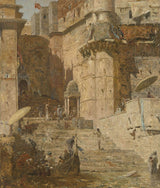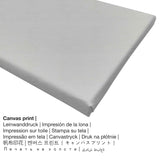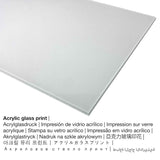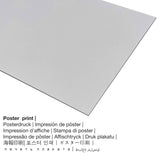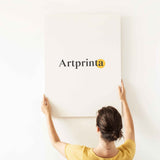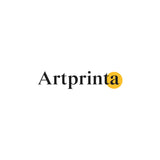Marius Bauer, 1913 - Benares, 1913 - ọmarịcha nka
Ụtụ gụnyere. Mbupu gbakọrọ na ndenye ọpụpụ.
Onyinye ngwaahịa ebipụta
Benares, 1913 was made by the artist Marius Bauer. Moveover, this artpiece belongs to the collection of Rijksmuseum in Amsterdam, Netherlands. a ngalaba ọha A na-enye ihe osise na nkwanye ùgwù nke Rijksmuseum.: . Ọzọkwa, nhazi nke mmepụta dijitalụ bụ ihe osise na nha 1: 1.2, nke pụtara na ogologo bụ 20% mkpụmkpụ karịa obosara.
Họrọ ngwa ngwaahịa gị
Maka mbipụta nka ọ bụla anyị na-enye ihe dị iche iche dị iche iche na nha. Họrọ nha na ihe kacha amasị gị n'ime nhọrọ ndị a:
- Mbipụta aluminom (aluminium dibbond): An Aluminium Dibond print is a print with a true depth. The colors of the print are luminous in the highest definition, fine details of the print appear crisp, and you can notice the matte appearance of the surface.
- Bipụta na enyo acrylic: A glossy acrylic glass print, often denoted as a an art print on plexiglass, will transform an original work of art into beautiful wall decoration. Moreover, the acrylic glass art print makes a great alternative option to aluminium and canvas prints. The artwork is being custom-made thanks to the help of modern UV direct printing machines.
- Akwụkwọ mmado na ihe kwaaji: The poster is a UV printed flat cotton canvas paper with a granular texture on the surface, which reminds the original artwork. Please note, that depending on the absolute size of the canvas poster print we add a white margin of something between 2-6cm around the work of art, which facilitates the framing with your custom frame.
- Kwaaji: A printed canvas stretched on a wooden stretcher frame. The advantage of canvas prints is that they are relatively low in weight, which means that it is quite simple to hang up your Canvas print without the help of any wall-mounts. Canvas prints are suitable for any type of wall.
Nkwupụta iwu: We try everythig possible to depict the products in as much detail as possible and to exhibit them visually in our shop. Still, the pigments of the print materials, as well as the print result might vary marginally from the presentation on your monitor. Depending on the settings of your screen and the quality of the surface, colors may not be printed one hundret percent realistically. Given that all art reproductions are printed and processed by hand, there may also be minor variations in the size and exact position of the motif.
Nkọwa ngwaahịa
| Nkewa edemede: | mmepụta nka |
| Mmeputakwa: | dijitalụ mmeputakwa |
| Usoro mmepụta: | Mbipụta UV ozugbo (mbipụta dijitalụ) |
| Mmalite nke ngwaahịa a: | emere na Germany |
| Ụdị ngwaahịa: | a na-achọ |
| Eji ngwaahịa a chọrọ: | ihe ndozi mgbidi, ime ụlọ |
| Nhazi: | usoro eserese |
| Oke akụkụ onyonyo: | 1:1.2- (ogologo: obosara) |
| Nsonaazụ nke akụkụ onyonyo: | ogologo bụ 20% mkpụmkpụ karịa obosara |
| Ihe mmeputakwa dị: | Mbipụta iko acrylic (nke nwere ezigbo mkpuchi iko), mbipụta akwa akwa, mbipụta akwụkwọ mmado (akwụkwọ kwaaji), mbipụta ọla (aluminium dibbond) |
| Mbipụta kanvas (akwa akwa na etiti ihe ndọtị): | 50x60cm - 20x24", 100x120cm - 39x47" |
| Acrylic glass print (nwere ezigbo mkpuchi iko) nhọrọ: | 50x60cm - 20x24", 100x120cm - 39x47" |
| Nhọrọ nha nke akwụkwọ mmado (akwụkwọ kwaaji): | 50x60cm - 20x24", 100x120cm - 39x47" |
| Nhọrọ aluminom dibond (ihe aluminom) nhọrọ: | 50x60cm - 20x24", 100x120cm - 39x47" |
| Nhazi mmeputa nka nka: | agunyeghi |
Data ndabere gbasara akụkụ nka pụrụ iche
| Aha nke ihe nka: | "Benares, 1913" |
| nhazi ọkwa: | sere |
| Okwu mkpokọta: | nkà nke oge a |
| Time: | 20th narị afọ |
| Year: | 1913 |
| Ogologo afọ nka nka: | ihe dị ka afọ 100 |
| Ụlọ ihe ngosi nka / mkpokọta: | Rijksmuseum |
| Ebe ebe ngosi nka: | Amsterdam, Netherlands |
| Weebụsaịtị ihe ngosi nka: | Rijksmuseum |
| Licensedị ikike: | ngalaba ọha |
| Site n'aka: | Rijksmuseum |
Ozi ndabere izugbe na onye na-ese ihe
| aha: | Marius Bauer |
| okike nke onye nka: | nwoke |
| Ọrụ onye na-ese ihe: | onye na-ese ihe |
| Nkewa onye nka: | omenkà nke oge a |
© nwebiisinka site na - Artprinta.com
Ihe ngosi nka site na Rijksmuseum (© - Rijksmuseum - Rijksmuseum)
Cut the stairs leading out of the river Ganges, India. In the middle a large stone steps, on the left is still partly see the Ramawahat Ghat (Ghat Ram), and the right, Brij Rama Palace. Spread on the stairs and people left in the foreground a boat in the river.

